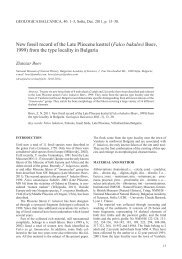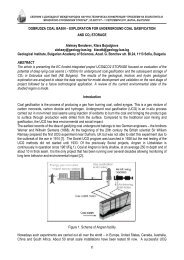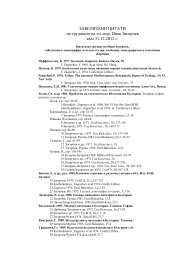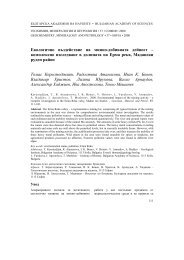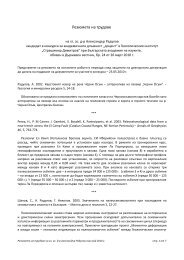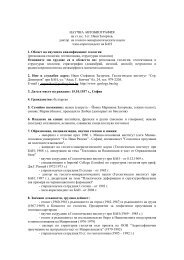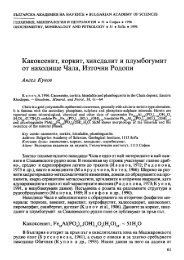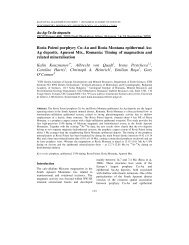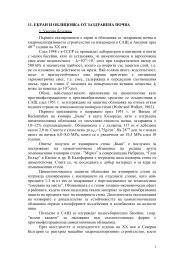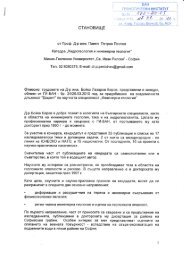Deinotherium thraceiensis sp. nov. from the Miocene near Ezerovo ...
Deinotherium thraceiensis sp. nov. from the Miocene near Ezerovo ...
Deinotherium thraceiensis sp. nov. from the Miocene near Ezerovo ...
Create successful ePaper yourself
Turn your PDF publications into a flip-book with our unique Google optimized e-Paper software.
hole (No 16; Áðúíêèí, Ñòàí÷åâà, 1965) situated<br />
<strong>near</strong> <strong>the</strong> village of <strong>Ezerovo</strong>, <strong>the</strong>se rocks are covered<br />
by massive limestones, marls, and well-cemented<br />
quartz sandstones. They are referred to <strong>the</strong> Oligocene<br />
on <strong>the</strong> basis of rich foraminifer and ostracod fauna.<br />
These rocks pass into <strong>the</strong> Lower <strong>Miocene</strong> dark gray<br />
aleurolites and marls with foraminifer and ostracod<br />
fauna similar to <strong>the</strong> Aquitanian-Burdigalian faunas<br />
reported in France (Áðúíêèí, Ñòàí÷åâà, 1965). The<br />
maximum thickness of <strong>the</strong> Lower <strong>Miocene</strong> is about<br />
180 m.<br />
The Palaeogene and Lower <strong>Miocene</strong> marine sediments<br />
are unconformably covered by fluvial sediments<br />
referred to <strong>the</strong> Ahmatovo Formation (Êîþìäæèåâà,<br />
Äðàãîìàíîâ, 1979). They crop out at numerous<br />
places in <strong>the</strong> valley of <strong>the</strong> river Cherkezitsa.<br />
At <strong>the</strong> basis <strong>the</strong>re are aleurolites and shales covered<br />
by sands of light rusty colour, alternating with conglomerate<br />
lenses. At places <strong>the</strong> sand layers are crossbedded.<br />
Petrified trees occur in <strong>the</strong> sands. The thickness<br />
of <strong>the</strong> sand layers varies <strong>from</strong> 1.5 m to 7.5 m;<br />
and that of <strong>the</strong> conglomerates is up to 1.5 m. The<br />
whole thickness of <strong>the</strong> sands has been revealed only<br />
by drillings and is up to 515 m. Ahmatovo Formation<br />
is referred to <strong>the</strong> Maeotian, Pontian and Dacian<br />
regional Paratethys stages. Three macrocycles<br />
have been distinguished (Êîþìäæèåâà, Äðàãîìàíîâ,<br />
1979). The first macrocycle is referred to <strong>the</strong><br />
Maeotian (possibly also upper parts of <strong>the</strong> Sarmatian)<br />
on <strong>the</strong> basis of Lower to Middle Turolian (“Pikermian”)<br />
mammal fauna. The Pontian age of <strong>the</strong><br />
lower parts of <strong>the</strong> second cycle is determined by Upper<br />
Pikermian (= Upper Turolian) fauna, and <strong>the</strong> upper<br />
parts of <strong>the</strong> second cycle are referred to <strong>the</strong> Dacian<br />
Regional Stage by Ruscinian fossil remains. The<br />
fossil locality of <strong>Deino<strong>the</strong>rium</strong> <strong>thraceiensis</strong> <strong>sp</strong>. n. belongs<br />
to <strong>the</strong> first cycle of <strong>the</strong> Ahmatovo Formation<br />
(Nikolov, 1985, p. 58).<br />
About 800 m west of <strong>the</strong> village of <strong>Ezerovo</strong>, right<br />
<strong>from</strong> <strong>the</strong> road to <strong>the</strong> dam, at <strong>the</strong> fork with <strong>the</strong> road<br />
for <strong>the</strong> pumping station, in light medium-grained<br />
sands, D. Kovachev found in 1965 <strong>the</strong> skeleton of<br />
<strong>Deino<strong>the</strong>rium</strong> <strong>thraceiensis</strong> <strong>sp</strong>. n. described in <strong>the</strong><br />
present paper. It was lying at a depth of ca. 40 m<br />
relatively to <strong>the</strong> level of borehole No 16. At <strong>the</strong> same<br />
level, but 50 m to <strong>the</strong> east, V. Tsankov and I. Vaptzarov<br />
have found in 1956 a part of a skull, determined by<br />
P. Bakalov as Trilophodon angustidens Cuvier. In 1962<br />
St. Stoykov and I. Nikolov found 4—5 m below <strong>the</strong><br />
find described here, teeth of Hipparion microtaton<br />
Nikolov and a part of a mandible of Mastodon <strong>sp</strong>.<br />
They all indicate a Maeotian age. Above <strong>the</strong><br />
deino<strong>the</strong>re have been found teeth of Hipparion mediterraneum<br />
Gervais and Tetralophodon longirostris<br />
Kaup. They unequivocally prove a Pontian age.<br />
After 1965, D. Kovachev collected <strong>the</strong> following<br />
fossils during numerous field trips:<br />
1. A skull, a mandible and bones <strong>from</strong> <strong>the</strong> limbs of<br />
Mastodon <strong>sp</strong>. In <strong>the</strong> structure of its molars it resembles<br />
T. angustidens Cuvier, but <strong>the</strong> tusks and <strong>the</strong> skull<br />
are different <strong>from</strong> this <strong>sp</strong>ecies.<br />
2. A whole mandible with a preserved symphysis and<br />
M 3 dext et sin of Choerolophodon <strong>sp</strong>.<br />
3. Two maxillary fragments with M 3 also belonging<br />
to Choerolophodon <strong>sp</strong>.<br />
4. M 3 sin et M 2 dext – Choerolophodon <strong>sp</strong>.<br />
5. Right semimandible with M 3 – Tetralophodon longirostris<br />
Kaup.<br />
6. M 3 sin – Anancus <strong>sp</strong>.<br />
7. M 2 and M 3 dext and M 3 sin – Zygolophodon borsoni<br />
Hays.<br />
8. M 3 dext – Zygolophodon borsoni Hays.<br />
9. M 3 sin <strong>Deino<strong>the</strong>rium</strong> giganteum Kaup.<br />
10. Right semimandible – Microstonyx major.<br />
They will be subject of o<strong>the</strong>r publications.<br />
The Neogene sands are covered by a layer of soil<br />
1.0 to 1.5 m thick including isolated rock fragments<br />
of different size. These soils are referred to <strong>the</strong> Pleistocene.<br />
Palaeontological part<br />
Order Proboscidea Illiger, 1821<br />
Suborder Deino<strong>the</strong>rioidea Osborn, 1921<br />
Family Deino<strong>the</strong>riidae Bonaparte, 1845<br />
Genus <strong>Deino<strong>the</strong>rium</strong> Kaup, 1829<br />
Type <strong>sp</strong>ecies of <strong>the</strong> genus <strong>Deino<strong>the</strong>rium</strong> giganteum<br />
Kaup, 1829<br />
<strong>Deino<strong>the</strong>rium</strong> <strong>thraceiensis</strong> <strong>sp</strong>. n.<br />
(Pl. I – XXII)<br />
Derivatio nominis: <strong>thraceiensis</strong> <strong>from</strong> Greek “Thraceia”<br />
– Thrace, <strong>the</strong> region of <strong>the</strong> find.<br />
Holotype. As such we design all <strong>the</strong> bones of <strong>the</strong> skeleton<br />
– No. 312/1 to No. 312/23-30, collection of <strong>the</strong><br />
Museum of Geology and Palaeontology of <strong>the</strong> Sofia<br />
University “St. Kliment Ohridski”.<br />
Locality. Light, medium-grained sands (Ahmatovo<br />
Formation, first cycle) <strong>near</strong> <strong>Ezerovo</strong>, Plovdiv region,<br />
just at <strong>the</strong> turn for <strong>the</strong> pumping station <strong>from</strong> <strong>the</strong><br />
road to <strong>the</strong> dam.<br />
Age. Maeotian.<br />
Diagnosis. Large animals, skull short and high. Nasal<br />
bones short, fusing at <strong>the</strong> anterior ends, curved<br />
and slightly flattened laterally. Large external nares.<br />
Ear area also large and with trapezoid shape. Eye<br />
sockets almost separated <strong>from</strong> <strong>the</strong> ear areas. Forehead<br />
high and, compared to <strong>the</strong> external nares –<br />
short. The occipital bone is high and wide. Symphysis<br />
of <strong>the</strong> mandible curved downwards and backwards.<br />
Incisors of moderate length, slightly curving<br />
outwards. Their tips end exactly beneath processus<br />
angularis. Neck short, with seven thin cervical vertebrae.<br />
First ones lack processus <strong>sp</strong>inosus, in <strong>the</strong> last<br />
ones it is weakly developed. Skull and mandible, relatively<br />
to <strong>the</strong> size of <strong>the</strong> whole skeleton, are much<br />
smaller than in <strong>the</strong> o<strong>the</strong>r proboscideans. Fingers high,<br />
with large phalanxes – hoofs, strongly developed on<br />
<strong>the</strong> third finger.<br />
11



